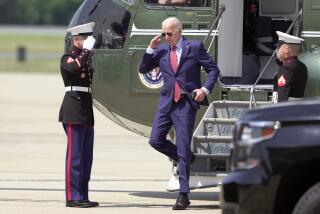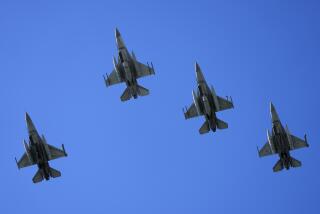U.S. to Seek Allies’ Help in Producing New Jet Fighter
WASHINGTON — The Reagan Administration is approaching the North Atlantic allies with an offer to jointly develop and produce a jet fighter for the start of the 21st Century, officials say.
The project, known as Hornet 2000, will be outlined today in Bonn, West Germany, by a high-level delegation of Pentagon and U.S. industry executives, according to government sources, who spoke on condition of anonymity.
The delegation will propose, essentially, that West Germany, Britain, Italy and Spain scuttle their own program, known as EFA--for European fighter aircraft--and join with American industry to develop a new version of the Navy’s F-A-18 Hornet.
The same offer might be made to France, which is developing yet another jet fighter, a source said.
The Administration sources claim the plan is both audacious and unusual. For the first time, one said, the United States is willing to jointly develop a new military fighter with foreign companies rather than perform all the development work in America and only then license it for co-production in another country.
“This hasn’t been done like this before,” the source said, adding the program envisions joint research and development; common production, with the Europeans enjoying a 60% share of that work, and joint exports to other countries.
The program, if accepted, would hold out the prospect of producing a plane that would be just as good as the EFA at a fraction of the cost, the source said.
But selling the idea will be difficult, added another official, because the Europeans are afraid that a failure to proceed with EFA will endanger the health of their aerospace industries.
The sources said the American delegation departed the United States on Saturday, led by Dennis E. Kloske, the deputy under secretary of defense for planning and resources. Kloske has been joined by top executives of the McDonnell Douglas Corp., the General Electric Corp. and Hughes Aircraft, the officials added.
The F-A-18 is built by McDonnell Douglas and is the Navy’s newest carrier-based fighter. The twin-engine jet can be configured for either air-to-air combat or air-to-ground strikes. GE is involved in the talks because of its production of jet engines, and Hughes is involved because of its work in the field of radar.
The Hornet 2000 plan stems from an order issued last fall by former Defense Secretary Caspar W. Weinberger, directing the Navy and Air Force to study means of modernizing and upgrading the F-A-18 and the F-16 Fighting Falcon for the year 2000.
The idea was to bridge the gap between current designs and new radar-evading “stealth” planes on the drawing board.
The Europeans, meantime, have been working on EFA designs for several years and must soon decide whether to authorize full-scale research and development. France refused to join the EFA effort, instead pursuing its own jet fighter known as the Rafale.
According to the Pentagon sources, it now appears an upgraded Hornet can be built at a cost of roughly $25 million per plane, compared to $55 million to $60 million for one EFA and $50 million for a Rafale.
The research and development work for the EFA will require between $8 billion and $10 billion; for the Rafale, between $5 billion and $6 billion, one source said.
By contrast, the Hornet 2000 can be built for about $3.4 billion “because we’ve already sunk $4.5 billion into the (basic) Hornet; it’s a proven aircraft,” the source said.
More to Read
Sign up for Essential California
The most important California stories and recommendations in your inbox every morning.
You may occasionally receive promotional content from the Los Angeles Times.










